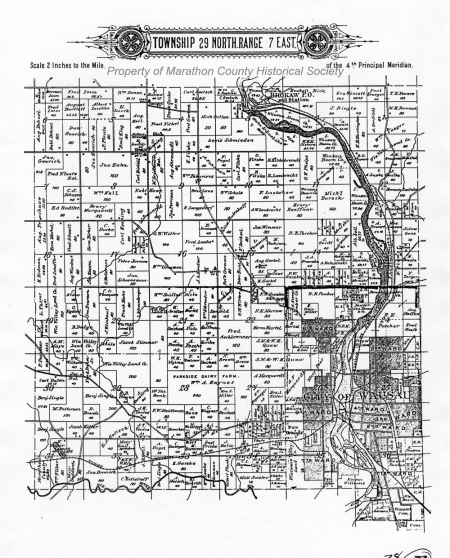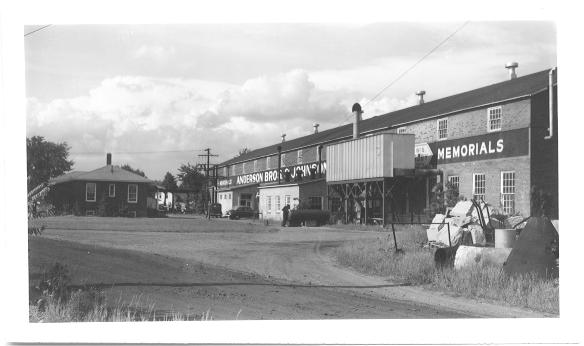Search our Places Database
Maine, Township of
Return To List of Locations | Back to Search
For more information on this location, please contact our research library.

Author:
Mary Moltzan
Location:
T. 30 N. - R. 7 E., west of the Wisconsin River & T. 29 N. - R. 7 E., northern and middle sections west of the Wisconsin River
Formallized:
November 12, 1866
Background:
Population: 1905-1,185, 2000-2,407.
At first extending from the Lincoln County border south through what is now the town of Rib Mountain and East through parts of the town of Texas, the township gained its present boundaries by 1892. The town of Maine was once heavily timbered with forests of pine and hardwood. The area was settled by German emigrants who bought the land from the government and speculators for as little as $1.25 per acre.
The first immigrant farmer to this area in 1856 was William Thiele who settled in T.30 - R. 6 which is now part of the town of Berlin. He had four brothers: Barteld, David, Gottlieb and Frank. Schueter, and Carl , nearest Wausau, was settled later.
First Public Official:
U. E. Maine
Biography:
Town chairman. The township was named after him. He had the largest farm at the time and was a onetime county surveyor. He was a native American whose wife was of Chippewa descent. They had a large family of sons.
Post Office Established:
January 10, 1870
First Postmaster:
John Kufahl
About The Post Office:
Maine P.O. was located NW 1/4 Section 31. The name was changed to Taegesville on June 22, 1891, with William Taege as postmaster, because so much mail intended for the state of Maine was being sent to Maine, Wisconsin. The P. O. was discontinued on October 15, 1901 with service from Wausau.
Trapp P.O. was located NW 1/4 Section 19 of Maine Township established May 15, 1872 with M. D. Coursy as postmaster. Service discontinued October 8, 1898.
Churches:
German Methodist Church - established in 1859. Log building (church) built in 1861, north of Taegesville, Section 30
Immanuel Lutheran Church - dates back to pre-Civil War days, Section 30
St. John's Lutheran Church - first church, a log one, built in 1866
Zion Lutheran Church (Faith) - first church, a log one, built in c1870, Section 8
Grace Lutheran Church - organized 1884. First church built 1884 in Taegesville, Section 30
Schools:
1. District #2, Taegsville School, Section 31
2. District #3, Valley View School, Section 5
3. District #5, Red Granite School, Section 16
4. District #7, Byron Valley School, Section 2
Business:
Gustav Stecklings Blacksmith Shop was erected before 1900. Part of the shop was used for woodworking. The original shop was torn down and a new one erected in 1909.
Karl Shield, being a blacksmith by trade, moved to Maine Township in 1865, purchased 40 acres of land, and started a blacksmith shop.
See Village of Taegesville
Industry:
Red granite quarries
Sawmill - 1866
Sawmill - built in 1917 by Emil Schlag, and William and Walter Steidtman
Brickyard - 1868 - F. W. Garske came from Germany in 1860 looking for clay soil with which to make brick. He settled in the Town of Maine. He made brick until 1900 when his son, H. E. Garske took over.
Cheese factories
Grist mill
Farming:
Farming was the leading industry in the area after logging. Early German emigrants cleared and cultivated the land to begin a major industry - dairying. Stumps as well as stones were used as fences to keep cattle confined. Split rails formed many fences also. By 1900, the earliest log structures were replaced with buildings of lumber. Horses were very important to the progress of these farmers. They provided power and transportation until inventions, such as the tractor, lightened the work load of both farmer and horse.
Ginseng - Early pioneers dug ginseng for profit. Ginseng was cultivated in the early twentieth century.
Experimental orchard - established in 1897 on ten acres. Soil tests were made to help determine whether the soil and climate were suitable for the growth of apple trees.
Fur farming - fox and mink farms
Stories:
Mission festivals were always filled with many activities and much hard work. These were conducted by local churches of Maine Township to carry out the mission work of the church. Everyone joined in the fellowship of working and playing together.
Sermons were held in the morning and afternoon. Following the morning sermon, a chicken dinner was served to all present.
The fun part was held in the nearby woods or park, often adjacent to the church. Games were played by young and old. One church member would bring a ram's head, complete with curled horns, and nail it to a tree. This marked the spot for those to gather who wished to play "Sheephead". Wooden dolls mounted on a wire would get bombarded with baseballs. "Kiggleball" was another favorite game. Other groups put on skits and plays which took a lot of time on the part of the director and performers.
Following the afternoon sermon, much time was spent enjoying refreshments and visiting with friends and neighbors and listening to the music of the church band.




